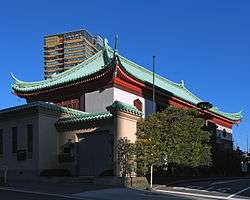Okura Museum of Art
| Okura Museum of Art 大倉集古館 | |
|---|---|
|
Exhibition Hall (1927) by Itō Chūta; reinforced concrete with bronze roof; Registered Cultural Property | |
| Alternative names | Ōkura Shūkokan |
| General information | |
| Address | 2-10-3 Toranomon |
| Town or city | Minato, Tokyo |
| Country | Japan |
| Coordinates | 35°40′1″N 139°44′36″E / 35.66694°N 139.74333°ECoordinates: 35°40′1″N 139°44′36″E / 35.66694°N 139.74333°E |
| Opened | August 1917 / October 1928 |
| Design and construction | |
| Architect | Itō Chūta |
| Architecture firm | Ōkura Doboku |
| Website | |
| Homepage | |
Okura Museum of Art (大倉集古館 Ōkura Shūkokan) is a museum in Tokyo, Japan.[1]
The museum opened in Toranomon, Tokyo in 1917 to house the collection of pre-modern Japanese and East-Asian Art amassed since the Meiji Restoration by industrialist Ōkura Kihachirō. The museum collection includes some 2,500 works, among which are three National Treasures and twelve Important Cultural Properties.[2]
The museum is located within the grounds of the Hotel Okura Tokyo. It has been closed for renovation since April 1, 2014.[2]
History
The Okura Museum of Art was the first private museum in Japan.[3][4] The museum and all the exhibits on display were destroyed in the 1923 Great Kantō earthquake although works then in storage survived.[5] The exhibition hall was rebuilt in 1927 by leading architect and architectural historian Itō Chūta and is a Registered Cultural Property.[5][6] The museum collection was subsequently augmented by the founder's son, Ōkura Kishichirō.[2]
Collection
The three National Treasures in the collection are a Heian-period wooden statue of Samantabhadra (Fugen Bosatsu in Japanese) riding on an elephant;[7][8] a scroll painting Imperial Guard Cavalry dating to 1247;[9] and a copy of the preface to the Kokinshū attributed to Minamoto no Shunrai.[10] Losses in the 1923 earthquake include one of the dry lacquer statue group of the Ten Great Disciples of which six survive at Kōfuku-ji (National Treasures).[8]
See also
| Wikimedia Commons has media related to Okura Shukokan. |
- List of National Treasures of Japan (paintings)
- List of National Treasures of Japan (sculptures)
- List of National Treasures of Japan (writings: Japanese books)
- List of Important Cultural Properties of Japan (Shōwa period: structures)
References
- ↑ Nussbaum, Louis-Frédéric. (2005). "Museums" in Japan Encyclopedia, pp. 671-673.
- 1 2 3 "Okura Shukokan - Outline". Okura Museum of Art. Retrieved 16 April 2012.
- ↑ "Prominent People of Minato City: Kihachiro Okura". Minato Ward. Retrieved 16 April 2012.
- ↑ Tseng, Alice Y (2008). The Imperial Museums of Meiji Japan: Architecture and the Art of the Nation. University of Washington Press. p. 224. ISBN 9780295987774.
- 1 2 Watanabe Hiroshi (2001). The Architecture of Tōkyō. Edition Axel Menges. p. 93. ISBN 3930698935.
- ↑ 大倉集古館陳列館 [Ōkura Shūkokan Exhibition Hall] (in Japanese). Agency for Cultural Affairs. Retrieved 16 April 2012.
- ↑ 木造普賢菩薩騎象像 [Wooden statue of Fugen Bosatsu riding on an elephant] (in Japanese). Agency for Cultural Affairs. Retrieved 16 April 2012.
- 1 2 Moran, Sherwood F (1965). "The Statue of Fugen Bosatsu Okura Museum, Tokyo" (PDF). Contemporary Religions in Japan. Nanzan Institute for Religion and Culture. 6 (4): 348–381.
- ↑ 紙本淡彩随身庭騎絵巻 [Imperial Guard Cavalry, emaki (colours on paper)] (in Japanese). Agency for Cultural Affairs. Retrieved 16 April 2012.
- ↑ 古今和歌集序(彩牋三十三枚) [Preface to the Kokinshū (33 sheets)] (in Japanese). Agency for Cultural Affairs. Retrieved 16 April 2012.
